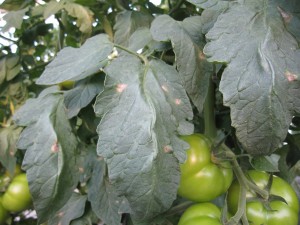Basic Information | Advanced Information | Diagnostic Information
Tomato Diseases | Powdery Mildew
Powdery Mildew
Symptoms
Leaves:
- Symptoms differ for each species of powdery mildew.
- A flat white moldy growth develops on the leaves.
- Bright yellow or green irregular spots form on the upper sides of leaves from Leveillula taurica infection, and then sometimes develop into necrotic lesions surrounded by yellow circles.
- A white mold develops on the undersides of the leaves from Leveillula taurica infection.
- White or grey splotches form on the upper sides of leaves and progress to the stems from Oidium neolycopersici.
- Rapid defoliation.
Fruits:
- Fewer and smaller fruits.
- Some fruits develop bright yellow spots.
- Fruits are unaffected from Oidium neolycopersici infection.
Signs
Branched conidiophores on the mycelium will be observed producing chains of 2 – 6 hyaline conidia under the microscope. The conidia of Leveillula taurica will be mostly tapered or pyriform, or “pear-shaped,” in shape and can be found in Glawe et. al. 2010. The mycelium of this species is found growing insides plant tissues, which differs from other species. The conidia of Oidium neolycopersici are rounded and can be found in IFAS Extension (pdf) and Jones et. al. 2001 (pdf). Sexual stages of this fungus have not been observed.
Often Confused With
- Leaf mold – An olive-green to grey velvety mycelium develops on the undersides of tomato leaves. Other symptoms include of yellow lesions and premature leaf drop.
- Botrytis grey mold – A white to grey mycelium growths on infected leaves, stems, and fruit.
- Early blight – Necrotic lesions with yellow halos develop on older leaves first, then progresses to younger leaves. The leaves eventually die and drop from the plant.
Isolation Media
- The powdery mildew pathogens are obligate pathogens and cannot be cultured.
Rapid Diagnostic Tests
- Conventional Polymerase Chain Reaction (PCR) Assays
- Primers LV-F/LV-R (pdf)




